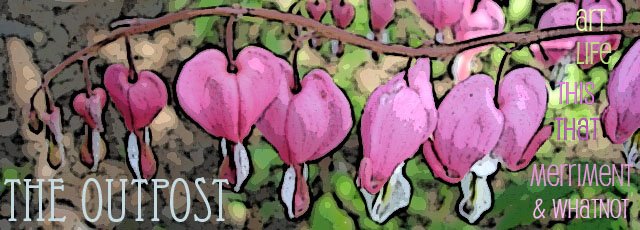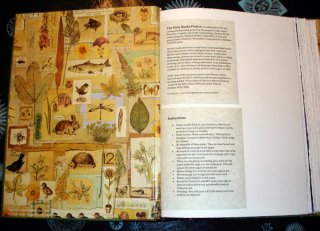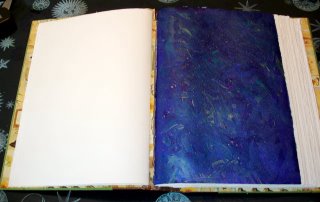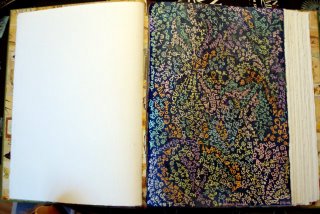
The final steps: (Warning! At this point jellyfish for the masses becomes labor intensive. I do this for 2 classes of about 23 K's. If you don't have lots of prep time or if you choose to do this for more classes you will want help!). Prior to class cut slits for stapling and tentacles 4 or so at a time using a template. Staple each circle into a bowl shape using an electric stapler. Refold crepe paper (the kind that is like yardage) so that it will fit in a paper cutter and cut strips. Unwind and cut several strips at a time into 3rds or 4ths. Before or during class pinch the center of the bowl and use a 1/8" hole punch for string handle. Thread a tapestry needle (long piece of yarn to do several at a time) and sew through the holes, cut off a length and tie. (Students older than 6 could do some of the above themselves.) Kinders will put a crepe paper strip through each slit at the edge of the bowl shape and glue the end down inside the jellyfish body.
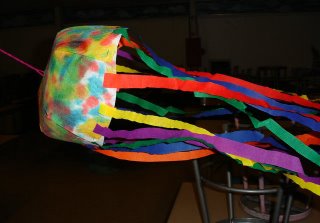
The milk filter jellyfish!
Before we start putting these together, I show a digital slide collection of jellyfish pictures and share the following facts:
***************
Jellyfish are not fish.
They do have a jellylike substance between two skins, an inner skin and an outer skin. Their bodies are a bell or umbrella shape.
They are about 95% water.
Jellyfish have no bones, no head, no brain, no heart, no eyes or ears.
They do have a nervous system. They breathe through their skin. They can react to light and smell and touch. They have a mouth, and tentacles that have poisonous cells. The poison helps them to capture prey.
Jellyfish have been around for more than 650 million years. They are found in almost all the oceans of the world.
They are invertebrates (no backbone) and are related to sea anemones and coral (creatures that sting and have a mouth in the center of their bodies surrounded by tentacles)
Jellyfish drift with the currents, but they do have a ring of muscles that contract to expel water from the umbrella-like body, and that will move them up or down in the water.
Some jellyfish are harmful to humans, but not all of them.
There are animals that eat jellyfish, like sea turtles. Some people also like to eat jellyfish.
Jellyfish range in size from about 1 inch to 7 feet. The tentacles can be up to 120 feet long.
******************
 These are spider ring bling. We did these at a Halloween party the other day. The idea came from the beadyeyedbrat Halloween pages online. First painted with acrylic paint, and then sprinkled or dipped in glitter. (A spritz of sealer after the paint dries will keep down "glitter dust".) Jewels, sequins, beads were added with a tacky glue dot ~ (it helps to have a tweezer and a steady hand for the smallest ones).
These are spider ring bling. We did these at a Halloween party the other day. The idea came from the beadyeyedbrat Halloween pages online. First painted with acrylic paint, and then sprinkled or dipped in glitter. (A spritz of sealer after the paint dries will keep down "glitter dust".) Jewels, sequins, beads were added with a tacky glue dot ~ (it helps to have a tweezer and a steady hand for the smallest ones). These are some big spiders that came in the plastic assortment; they're about 3-4 inches from tip to tip though they look smaller in this picture than the rings. Tiny dots of color and decoration can be added with a 3D paint like Scribbles. One could also apply the baubles with one of those fancy tools that heat already-applied adhesive on the back of the jewels. Could also use glitter glue, and I might try a bit of gold-leafing today!
These are some big spiders that came in the plastic assortment; they're about 3-4 inches from tip to tip though they look smaller in this picture than the rings. Tiny dots of color and decoration can be added with a 3D paint like Scribbles. One could also apply the baubles with one of those fancy tools that heat already-applied adhesive on the back of the jewels. Could also use glitter glue, and I might try a bit of gold-leafing today!
